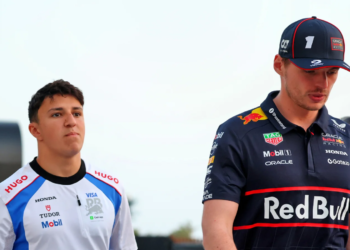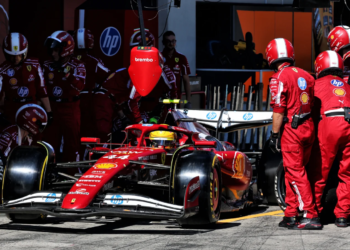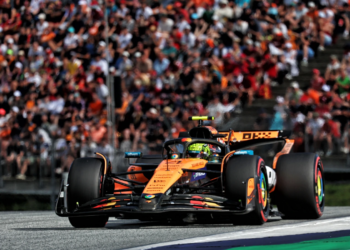Formula 1’s Silly Season exploded into life through the summer of 2018. Motorsport Week reflects on how it unfolded.
Formula 1 entered 2018 with only two drivers having firm locked-down contracts for the following year: Sebastian Vettel, at Ferrari, and Max Verstappen, at Red Bull. Early on, it was a waiting game: namely waiting on Lewis Hamilton.
Hamilton was always poised to extend his tenure with Mercedes but no-one else moved until pen had been put to paper, just in case. Mercedes had kept Valtteri Bottas on a one-year deal from 2017 into 2018 and his greater turn of pace early doors, even accounting for not adding to his win tally, made an extension an expectation. Still the waiting game went on. Discussions were put on the backburner for a while as Mercedes focused on extracting more from its package. “We are not really far away from finishing things so it will happen hopefully in the near future,” Hamilton said in May, shortly before an initial agreement was reached, sometime around the Monaco GP weekend. The final details were finally ratified after several weeks of back-and-forth, after which Mercedes turned its attention to Bottas, opening talks at the British Grand Prix. That deal was swiftly wrapped up. Mercedes announced Hamilton’s two-year extension on Thursday morning at the German Grand Prix, with Bottas’ one-plus-one contract duly confirmed 24 hours later.

That turned the attention onto Daniel Ricciardo, on whom much focus had already fallen through the early phase of the European season – or indeed before, much to his chagrin. From the outset he was batting away questions about his 2019 options that were being bowled left right and centre. There were mixed messages being emitted as Ricciardo tried to keep doors open at Mercedes and Ferrari, not burn any bridges with Red Bull, while Renault and McLaren, the latter wary Fernando Alonso was edging towards the exit, chased the Australian. Ricciardo quipped at June’s French Grand Prix that a new project held some appeal but the overwhelming consensus was that staying put at Red Bull was deemed likely. Talks were held with Red Bull senior figures through the course of its home event in Austria and it believed an agreement had been reached. Only Ricciardo never signed. As the circus departed Hungary, with Ricciardo having tested on the post-race Tuesday, Red Bull expected him to stay. On the Thursday he rang senior management to inform them he was off to Renault, motivated by the desire for a fresh challenge, having spent a plane journey to the US weighing up his life, leaving Christian Horner and Helmut Marko shocked. The news was made public the next day, along with confirmation that Nico Hulkenberg would be staying at Renault.
If Mercedes’ announcement acted as the starting bell then Ricciardo’s move split open the market.
Mercedes had moved to place protégé Esteban Ocon at Renault for 2019, with an agreement in principle reached, only for Renault’s swoop of Ricciardo to end that avenue. Meanwhile, Force India’s tactical administration meant another plot line was bubbling away, though attention was to go elsewhere first.

Fernando Alonso’s future had been a key talking point through 2017 before he eventually penned an extension, and again his 2019 plans were in the spotlight through the European rounds of the championship. Alonso remained coy, often shrugged his shoulders, all while knowing a decision had been made, one he teased for several days before announcing on August 14 that he would be leaving the championship, blaming the sport’s predictability, the desire for new challenges, and McLaren’s uncompetitive situation. McLaren stressed it had a replacement lined up and it transpired to be Carlos Sainz Jr., who was already poised to lose his Renault seat to Ocon before the Ricciardo swoop. Sainz Jr. was naturally under consideration to replace Ricciardo at Red Bull but an indifferent 2018, and past situations, left Pierre Gasly as the favourite. Red Bull duly confirmed Gasly as Max Verstappen’s team-mate a few days later.
Formula 1 reconvened in Belgium with several situations yet to be wrapped up – and a developing one that meant the 2018 silly season could have had in-season, rather than next season, changes. Force India’s descent into administration had lasted for only a short period of time before a group of investors, under the Racing Point banner, led by Lawrence Stroll, stepped in to save the team. The name had an impact – where would son Lance be racing? Rumours of an immediate switch were raised but never materialised, as Ocon dazzled by qualifying third on the grid – before telling Vettel in the press conference that he was set to lose his seat. Sergio Perez, meanwhile, asserted that he had finalised a 2019 contract through refused to divulge further details. Stroll had a seat fitting between Belgium and Italy but the composition of the grid did not change, and indeed remained the same way through Abu Dhabi, marking the first time there was not a single alteration all season.
As that Force India situation rolled on, so did ones at McLaren and Ferrari.

McLaren was weighing up Ocon – understood to have had a seat fitting earlier in the summer where concerns over his height were raised – Perez, incumbent Stoffel Vandoorne and reserve driver Lando Norris. The last named was always regarded as the favourite from an external perspective, and McLaren did little to quell such thoughts by handing Norris FP1 runs in Belgium and Italy. Vandoorne, though, still laid out his case for the defence by insisting he wanted to stay – though was notably spikier in his attitude. As he prepared to hand out Haribo to McLaren members on Sunday lunchtime at Monza Norris was called into Zak Brown’s office, where he was given the good news, which was made public the following morning. Toro Rosso had previously tried to nab Norris as a mid-season replacement for the ailing Brendon Hartley and sources suggested that Norris’ contract stipulated a decision had to be made for his 2019 plans by September/October. McLaren acted. Sainz Jr. and Norris. McLaren sorted.
Ferrari also made a decision around that time and it was that Kimi Raikkonen was to be replaced by Charles Leclerc, the new senior hierarchy of Chairman John Elkann and CEO Louis Camilleri putting their faith in the highly-rated youngster who was the late Sergio Marchionne’s favoured son. Maurizio Arrivabene informed Raikkonen of his impending exit on Thursday at Monza, after which the Finn’s management team turned to Sauber, where a deal was swiftly reached. Leclerc was phoned by Arrivabene on the free weekend between Italy and Singapore and informed of his promotion. The news became public the following Tuesday; Leclerc’s move was expected but Raikkonen’s less so, essentially taking one more seat off the marketplace.
Thus by Singapore five teams had publicly confirmed their 2019 line-ups, with Force India all-but-sorted, ostensibly leaving vacancies at Haas, Toro Rosso, Williams and one berth at Sauber.

Perez again stressed that he had a 2019 deal sorted but Ocon’s prospects were fading. “There are still hopes, yes, but less and less,” said Ocon ahead of the Singapore Grand Prix. “That's a bit why I'm disappointed at the moment, to see that it's not only results that come in play, it has to be other things. It's hard to believe that I was in a great position two months ago and things have gone that way now.” Vandoorne, meanwhile, felt his chance of staying on the grid were “very slim.”
More announcements trickled through across the following weeks.
Antonio Giovinazzi’s patience was finally rewarded with news that he would join Raikkonen at Sauber. The team was keen to point out that Giovinazzi was not a replacement for Marcus Ericsson, who accepted a third driver/ambassadorial role, but rather for Ferrari-bound Leclerc. Ergo, Giovinazzi, and not Raikkonen, acted as the Alfa Romeo link.
Haas was one of the quietest teams in the silly season and duly kept hold of Kevin Magnussen and Romain Grosjean, who had redeemed himself after a lacklustre start to 2018, while the next day Daniil Kvyat’s third stint as a Toro Rosso driver was announced, with the Russian having begun and consequently accelerated discussions in the wake of Ricciardo’s Red Bull exit. Red Bull recognised that a year away as Ferrari’s development driver had aided Kvyat’s maturity, with his prospects helped by a lack of viable alternatives.
George Russell spent much of the Japanese Grand Prix weekend with a bounce in his step and a few days later the reason became public, with confirmation that the F2 champion elect would join Williams. Mercedes, and Williams, was keen to assert that Russell – who had begun discussions at his own accord at Hockenheim in July – was chosen for talent alone.

As Kvyat returned and Russell joined, two erstwhile rising stars pledged their allegiance to Formula E. Vandoorne confirmed the open secret that he’d be joining Mercedes’ affiliate HWA while Pascal Wehrlein, having severed his Mercedes ties in order to keep his Formula 1 hopes alive, accepted defeat in his pursuit of a Toro Rosso drive and signed for Mahindra. They got to grips with their new surroundings in Valencia in mid-October.
But one of their anticipated rivals did not test all week in spite of having a signed three-year deal with Nissan. Step forwards Alexander Albon, a former Red Bull protégé and ex-Gravity academy member whose exploits left him idolised by Norris, and highly rated by the likes of Gasly and Leclerc. Albon did not take the reins of Nissan’s Formula E car, with Oliver Rowland filling the breach for the final of three days, as rumours swirled.
Perez’s 2019 plans were eventually announced in the build-up to the United States Grand Prix, with the expected news that he would spearhead Force India’s charge. No surprise on that one.
Through mid-late 2018 Sergey Sirotkin remained confident of seeing the fruits of his labour next year but as the weeks trickled on it was apparent that SMP Racing was less than enthusiastic over continuing the collaboration with Williams. Allied to Robert Kubica’s presence, and the manner in which he impressed the team, along with his financial contribution, and the Pole was installed as favourite. Confirmation of his 2019 position was duly confirmed at a well-attended press conference atop Williams’ hospitality building on the Thursday of the Abu Dhabi Grand Prix weekend, completing a remarkable journey from near-death to a return to a Formula 1 race seat, a fairy-tale eight years in the making. 24 hours later, and with his last option having gone, Ocon was confirmed as Mercedes’ 2019 test and reserve driver.

That left two positions to be filled – and the identities of their occupants were obvious, though Brendon Hartley remained adamant that he had a 2019 contract, repeating the lines he had trotted out for several months, but such confidence proved misplaced. Fewer than 24 hours after Formula 1’s season finale Nissan confirmed that it had released Albon from his contract. Albon received a call from Red Bull while at a mall in Abu Dhabi that he would be a 2019 Toro Rosso driver and before the day was out the move was made public. Albon appeared in the Yas Marina paddock the following day to get assimilated with his new team.
And then there was one. The one that was the most obvious all along. And yet, still no confirmation.
Lance Stroll confirmed on Thursday at Yas Marina that he would be testing for Force India and on Tuesday afternoon he hopped into the VJM11, remaining in the car through Wednesday’s running. Finally, on Friday afternoon, the final day of November, Force India confirmed Stroll would partner Perez in 2019, completing its driver line-up and officially filling the 20-car grid.
It means that double the number of teams have had a complete overhaul than have stayed put, and only eight of the 20 participants will don the same overalls which they removed at the 2018 finale.
And breathe. Surely 2019/20 won’t be quite as silly… surely?







